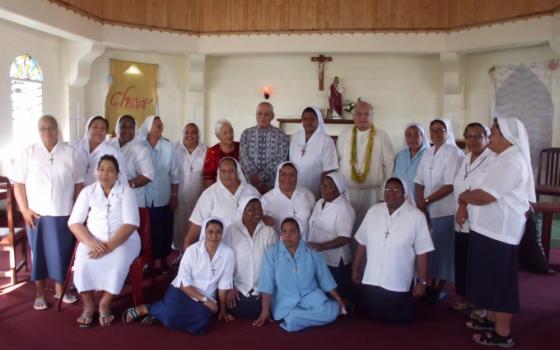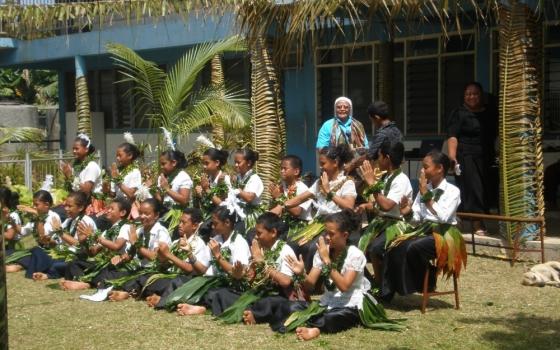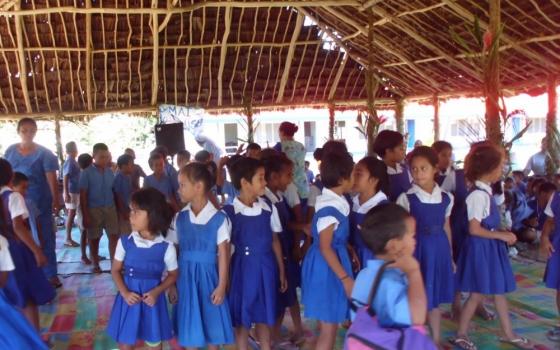Remember the romantic musical "South Pacific"? The idyllic life where people lived peacefully together in unlimited sunshine surrounded by white sandy beaches, swaying palm trees and turquoise waters was so mesmerizing. Unfortunately, our fantasies keep us from seeing some of the harsh realities beyond the beaches.
South Pacific life is not idyllic for many families in the rural areas of the numerous islands. Some still survive on subsistence farming and/or fishing with the added effects of global warming. Few have electricity or telephones, and no one has internet access. Women and girls wash clothes by hand and cook on wood-burning stoves. Walking or motorbiking are the primary means of land transportation because of few developed roads. There are a few bus access points for travel to the cities, but the buses are not always reliable.
Accompanying these families are sisters who, as in other parts of the world, are committed to bringing God's love and care through ministries of education and health and social services. I was fortunate in 2013 to meet Sr. Judith Moore in the Philippines, where she was attending AMOR (Asian Meeting of Religious). She was the provincial of the Missionary Sisters of the Society of Mary and also the secretary for the Conference of Religious Women and Men.
A few months ago, I interviewed her on Skype, but soon afterward, she was elected to the general leadership of her congregation and moved to Rome. Judith spent 20 years of her life in ministry in the South Sea islands in a variety of roles.
As we began our conversation, Judith reminded me that her descriptions are generalized because each South Sea island has its own unique culture and lifestyle. Members of the Conference of Religious Women and Men live on the islands of Fiji, Samoa, Kiribati, Tonga, Papua New Guinea, Marshall Islands among others.
She also wanted me to understand that even though religious on the islands often feel isolated from the rest of the world, the universal church is very important to them. They seek opportunities to keep connected to what is happening in the global church. Thus, four sisters from Fiji and Samoa attended the 2015 congress for young religious in Rome, and others participated in the closing meeting of the Year of Consecrated Life in January 2016. Helping both female and male religious take advantage of such opportunities takes up a lot of Judith's time, as does seeking funding for travel and meetings.
GSR: What is the role of the secretary for the Conference for Religious Women and Men?
Moore: Being the communication link is of primary importance. This means assisting the congregations to stay up to date on what is happening in religious life worldwide.
I also organize intercongregational programs for formation for young sisters. There is an annual final vow preparation for them and an ongoing formation program for sisters after 10 years of profession of vows.
We also have enthusiastic vocation promotion programs. Although right now, we have a steady stream of new vocations, the sustainability of vocations on the islands is a big question as it is everywhere else. One of the things impacting vocations is out-migration. Life in the South Pacific is vulnerable and becoming more so with natural disasters and climate change. As families do not see a future for themselves, they think of moving on.
How does the geography of the Pacific Island world impact religious life?
The population is spread across hundreds of islands, although some of them are too small to support day-to-day life. There are 18 islands designated as countries and 14 archdioceses in the South Pacific region. Because we are surrounded by water, transportation and communication with conference members is very challenging. Even though we know that staying connected is so important, technology that could be a help is often not available. To attend meetings, conference members have either to fly or travel by boat. Both are very expensive, so we only meet once a year. All of these things make conversation and collaboration difficult.
How many congregations of women are there in your region of the South Pacific?
There are 10 congregations in Fiji, including two Carmelite enclosed communities. The Sisters of Our Lady of Nazareth is the only locally founded apostolic group and is under the jurisdiction of the bishop. The other eight were founded in Europe, primarily France, and one is from New Zealand. However, today, the international groups have mostly local women from the various islands of the region. The missionary communities tend to be intercultural: local island women, European sisters and some from other global south countries.
Although locally founded in Fiji, the Sisters of Our Lady of Nazareth is also international. It even has a small community of sisters in Hanford, California, where the sisters minister to families from the South Pacific. Their sisters have entered from some of the nearby islands as well as Fiji.
In the Solomon Islands and Papua New Guinea, there are four locally founded groups. Their memberships are small.
What are the ministries of the sisters?
Most of the sisters work in schools, either their own or those belonging to dioceses. They sometimes teach under formidable conditions, often without books or materials. The dream of one computer for each child is just that — a dream. It is expensive to import books and materials, and families usually do not earn enough to even cover tuition and supplies. Continuing teacher education is sometimes problematic as well for the sisters and their lay partners, especially on islands where resources of personnel and money are limited.
Naturally, most sisters are very interested in girls' education. In general, on many of the islands, girls suffer from culturally based discrimination and practice. They need support and education to recognize their value and to understand that they have rights to education and safety.
There is frequently pressure on the girls to earn money for their families, so they are tempted to leave school to help out. Some of the countries — Fiji is a leader — now have policies of child protection that have been ratified and education of the population is ongoing to provide girls with safety and basic human rights. As laws are enforced, there is less danger too of sex and labor trafficking of girls.
Sisters also work in dispensaries and a few in hospitals. Even though catechesis is a much-needed ministry, not many sisters work in parishes because stipends are just too small for them to contribute to meeting the needs of their communities for education, health care and daily living. Catechizing is done by lay volunteers from the parishes.
Elders have a special place in all island families and have usually been cared for at home, but today, times have changed somewhat. Family members have to work outside the home and need support in caring for parents. Sisters are stepping into this important ministry.
Some sisters are active in women's crisis centers, particularly in Tonga, Solomon and Samoa. Domestic violence and abuse have been relatively hidden issues until recently. Making abuse public often breaks down family systems and community respect, so the process is slow.
Alcoholism is also prevalent because of unemployment, especially in the atolls of Niru and Kiribas. We are learning too that leprosy is increasing in Kiribas due to congested living conditions. Family houses are small and lack clean water and sanitation, which adds to the vulnerability. This is true also of the Marshall Islands. Many of the people from here have migrated to Iowa and Arkansas to seek employment and, in general, a better life.
What are some of the issues religious congregations face in this island culture?
As I mentioned before, the greatest one is the isolation because of expensive travel and lack of access to communication technology. Another challenge for young women entering religious life is negotiating their new identity. Family is central to island cultures, so women struggle with extended family expectations and responsibilities and, in turn, responsibilities to their communities, particularly when it comes to divesting of land ownership and inheritance. There is ongoing dialogue about, 'Who is my first family?'
So tribalism is an issue?
Not in Fiji or other islands, but in Papua New Guinea, yes. There is much diversity in PNG because of the distances and terrain. Social justice issues regarding mixed blood is a cultural challenge on most of the islands because of migration between islands and also immigration from other parts or Asia and Europe. Land issues are particularly sticky because there is so little of it.
Would you say that the sisters have enculturated religious life in the South Pacific — that is, integrated the best practices of the local culture?
As in most countries where missionaries are returning home and the indigenous membership is growing, these are issues that are in discussion. It is not easy to sort out what of any culture is appropriate to incorporate into religious life. But the strong sense of family and joy of life are definitely aspects of the culture that are very present. Another that is very positive is communal prayer. Families and villages hold communal prayer each day, so this is a practice that fits well into religious life.
What kind of prayer life do the sisters practice?
The active communities have morning and evening prayer in common and, of course, daily Mass, which they attend together. Sometimes in the towns, a priest celebrates Mass in the convents. In rural areas, the sisters attend the parish Mass. Most communities have a monthly retreat day and an annual retreat of longer length. Communal life here on the islands is strong, another gift from the culture.
At what age would women ordinarily enter the convent?
They usually enter in their 20s, but even then, they may not have a grade 12 education or much life experience, particularly in the Solomon Islands. Women there struggle to attend school at all. In Fiji, higher education is possible at the regional University of the South Pacific, and this is now becoming available in Samoa. The regional university has colleges of medicine, nursing, computer science and education. Although there are government scholarships available for university study, religious usually do not take advantage of them. Few sisters in the South Pacific have higher degrees.
Sisters can acquire teacher training, but there are no degrees yet. Many are ministering in their schools and dispensaries with only diplomas. Others may do a three-month pastoral course, but it is expensive to go so far away.
So religious life is thriving in the South Pacific. What is its greatest contribution to global religious life?
Religious life is very much alive and well in the South Pacific. The sisters are very enthusiastic and joyful about their life, even though they face many challenges. Life can be very hard, particularly in rural areas, but the sisters are generally adaptable and used to a simple lifestyle, often coming from rural families. Retention of vocations is very good here and part of this is due to excellent formation of new members and ongoing formation. The sisters have a great faithfulness to the universal church, and probably because of their isolation have a strong consciousness of belonging to that universality.
I would say that the greatest contribution of the South Pacific to global religious life is joy and happiness, a gift from the people of the islands to their daughters who carry it into community life.
[Joyce Meyer is a member of the Sisters of the Presentation of the Blessed Virgin Mary and is GSR's liaison to women religious outside of the United States.]




